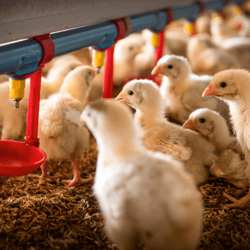- Posted by Anitox
The Clostridium Conundrum
What is Clostridium?
Clostridia is typically defined as a gram-positive, spore-forming bacterium. But what does that even mean?
If you already know the answer to that question, skip ahead to the next section. ‘Form relates to function’ is a statement that rings true for nearly everything in life. To accomplish an intended action, the object or being intended to perform that action needs to be physically adequate. Bacteria need to infect and exist within a host that helps meet their functional needs. Gram-positive bacteria have thicker cell walls containing more peptidoglycan, but they are missing an outer membrane. This means gram-positive bacteria are more permeable to substances surrounding them and, in some cases, have sophisticated ways of attaching to their host by attachment proteins. It is important to note that some Clostridium species are gram-negative; however, the gram-positive ones are typically the strains of high interest to human and animal health. Spores are Clostridia’s most incredible tool. Spores are a thick-walled structure that can survive the harshest of conditions. When conditions become more favorable, these spores can germinate and become a cell that has an active metabolism and can reproduce.
Clostridium in Chickens
Clostridia are naturally found in soil and intestinal tracts. Well adapted for intestinal tracts, Clostridia can colonize birds. Clostridium perfringens is of particular interest because of its ability to produce toxins and enzymes that lead to lesions within the intestinal tract and symptomatic birds. Clostridium in chickens leads to diseases such as necrotic enteritis.
It’s important to understand that C. perfringens doesn’t descend and immediately cause destruction to a healthy bird. For Necrotic enteritis to occur, there are some prerequisites, the first being intestinal damage. Dr. Hofacre, professor emeritus at the University of Georgia’s College of Veterinary medicine and president of Southern Poultry Research Group outlined some causes of intestinal damage at the 2020 Virtual Poultry Tech Summit:
-
- Coccidia
- Mycotoxins
- Certain feed ingredients
He also explained that intestinal wall damage creates a situation where the gut produces mucus as a protective mechanism. Unfortunately, this mucus also serves as a food source for C. perfringens, making colonization and toxin production easier and ultimately leading to necrotic enteritis.
Necrotic enteritis doesn’t discriminate when it comes to poultry, impacting broilers, layers and turkeys. Typically seen more in younger stock, the disease progresses rapidly, ending in death. However, C. perfringens doesn’t always lead to necrotic enteritis. Sometimes its impact is milder, commonly referred to as subclinical form. This milder infection causes decreased weight gain and poor feed conversion due to the disruption in digestion and absorption within the intestinal tract.
Clostridium on Poultry Feed Safety
Farms profit on birds that lower feed conversion rates and reach their full growth potential in a timely manner. To achieve this, producers allocate between 60 and 70 percent of production investment on feed expense. If birds cannot effectively digest feed and absorb nutrients required to grow, then money is wasted – that’s how Clostridia impacts farms. Whether in its clinical form or subclinical form, Clostridia infection disrupts digestion and bird growth.
While being the largest production investment, feed as a fomite is part of the problem. The recent study, Evaluation of commercially manufactured animal feeds to determine the presence of Salmonella, Escherichia coli, and Clostridium perfringens found that Clostridia spp. are likely to contaminate most feed ingredients and mixed feeds. Approximately 60% of ingredients and 84% of mixed feed samples tested were contaminated. These findings weren’t surprising, as other sources have noted similar results. However, it is interesting to note that the researchers found no real difference in the percent of Clostridia contamination throughout the stages of feed processing.
Clostridium perfringens Prevention
As mentioned, Clostridia naturally occurs in the environment and intestinal tracts, only becoming a problem when Clostridia populations are so prolific that they can capitalize on opportunities. Opportunity results from intestinal injury, to prevent Clostridia infection its essential to do two things:
-
- Prevent intestinal injury
- Mitigated Clostridia populations within the operation
A healthy gut creates a healthy bird. Gut health and integrity are established through proper bird management, quality feed and generally taking actions to reduce environmental stress. Interventions that can be taken to create a holistic approach towards the prevention of a Clostridia infection are:
-
- Support of a healthy gastrointestinal microbiome
- Vaccination
- Biosecurity measures
- Poultry house sanitation
- Feed pathogen control
Feed pathogen control is a critical part of mitigating Clostridia within poultry production and reducing the introduction of other pathogens that deteriorate bird health. Poultry feed safety is necessary. Feed sanitizers help keep feed clean and ensure that it is challenge-free until the point of consumption through their long-lasting action in feed.
For more information on feed pathogen control speak to an expert today.


.png?width=250&name=Untitled%20design%20(18).png)
